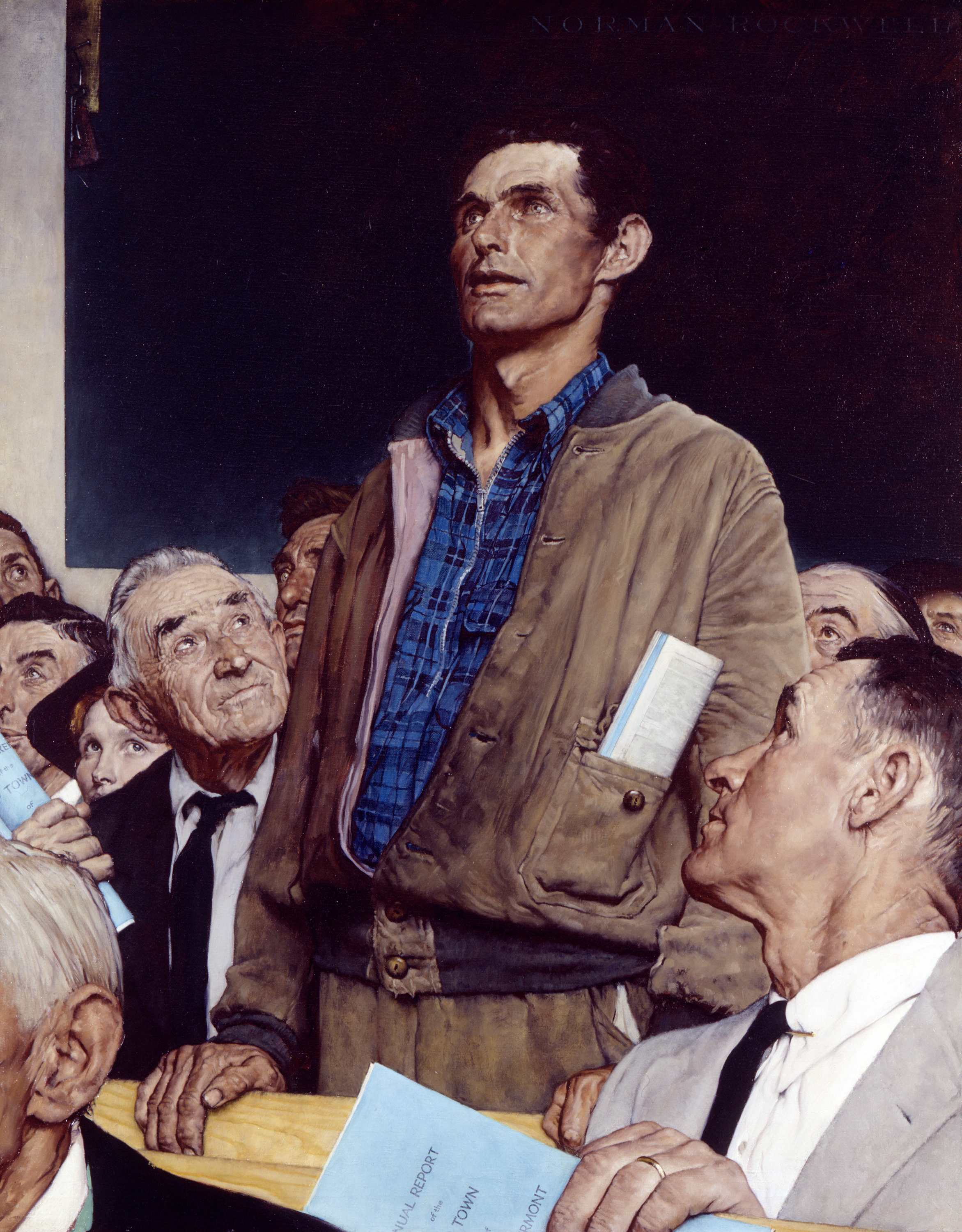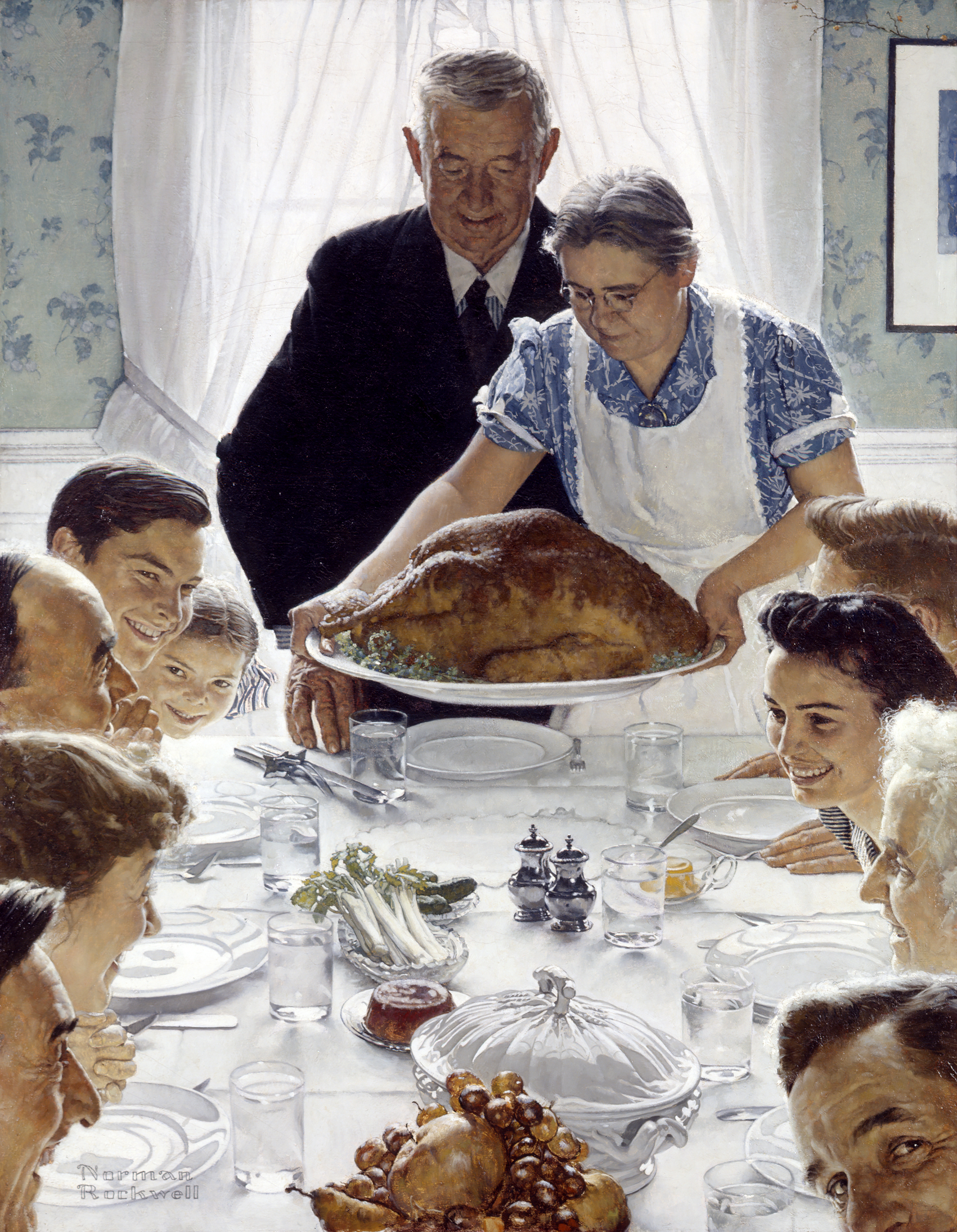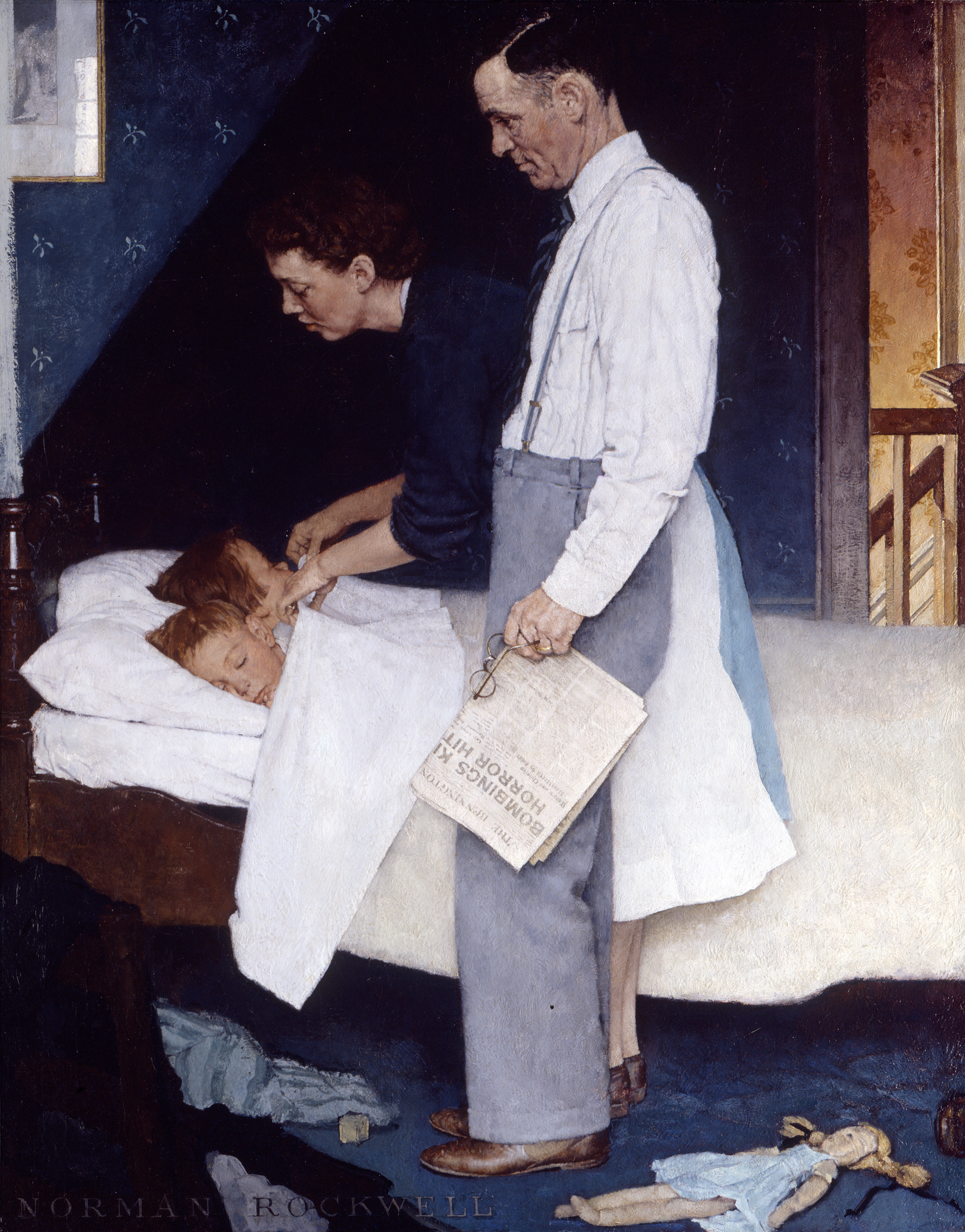A Visual Exploration of the Four Freedoms
Overview:
Students will be introduced to the Four Freedoms, which President Roosevelt identified in his 1941 address to Congress. Each of these freedoms, including Freedom of Speech, Freedom of Worship, Freedom from Want, and Freedom from Fear will be addressed individually. By creating a visual inventory of Norman Rockwell’s Four Freedoms illustrations, students will identify and analyze details in his paintings.
This lesson is designed for two 60 minute class periods.
Enduring Understandings/ Essential Questions:
- President Roosevelt made a speech about the four main freedoms he felt that everyone everywhere in the world was entitled to.
- Norman Rockwell wanted to paint pictures of the Four Freedoms for the American people to help them understand what the president’s speech was about, and what these freedoms might look like in their own lives.
- Art is inspired by many things, including ideas, everyday life, and the world around us
- What is the importance of President Roosevelt’s Four Freedoms speech?
- How did Norman Rockwell’s personal experiences and surroundings influence his paintings?
- Grade
- 9-12
- Theme
- FourFreedoms
- Length
- This lesson is designed for two 60 minute class periods.
- Discipline
- Art
- Vocabulary
- Beliefs; Citizenship; Composition; Confidence; Foreground, middleground and background; Newspaper
Objectives:
- Students will share any prior knowledge about the Four Freedoms (President Roosevelt’s speech or Rockwell’s paintings).
- Students will create a visual inventory of each painting.
- Students will use prior knowledge to make associations with the subject matter and historical events.
- Students will identify visual metaphors within the illustrations.
Background:
World War II began in 1939. The United States was not involved in the beginning of the war, however, President Franklin Roosevelt believed that the United States would eventually need to play a larger role. In January 1941, he made his speech to Congress. In his speech, President Roosevelt named the Four Freedoms, which he stated are the rights of everyone in the world.
After the speech, in an effort to convey the underlying message of the Four Freedoms, the President reached out to the art world for help. Many artists created works to reflect the meaning of these freedoms in the form of paintings, sculptures, prints, musical compositions, and more.
Norman Rockwell thought a lot about these ideals. In February and March of 1943, his completed Four Freedoms illustrations were published in The Saturday Evening Post, each along with a related essay. Exceedingly popular at the time and distributed widely as prints and posters, Norman Rockwell's illustrations raised over 132 million dollars toward the war effort, through the purchase of war bonds. Prints of Rockwell’s Four Freedoms were given as premiums when people purchased war bonds in varying denominations. His illustrations became the face of the Four Freedoms and they continue to represent the meaning of these freedoms today.
Materials:
Multimedia Resources
Freedom of Speech
Freedom of Worship
Freedom from Want
Freedom from Fear
Franklin D. Roosevelt's Four Freedoms
Norman Rockwell Museum
Norman Rockwell's Four Freedoms
Norman Rockwell Museum
A Conversation with Ruby Bridges Hall
Norman Rockwell Museum
Womanpower: The Fight for the Four Freedoms
Norman Rockwell Museum
The Atlantic Charter: Hope for a New World
Norman Rockwell Museum
Classroom Supplies:
- Easel, whiteboard or chalk board for writing on
- Norman Rockwell’s Four Freedoms: Images that Inspire a Nation by Stuart Murray, and James McCabe
- Four Freedoms Group Analysis Worksheet (5-12)
- Reading handout Excerpt from President Roosevelt’s Four Freedoms Speech
- Reading handout Excerpt from Norman Rockwell, My Adventures as an Illustrator by Norman Rockwell
- The Atlantic Charter: https://digital.library.unt.edu/ark:/67531/metadc581/
Additional Teaching Resources:
A Variety of books on Norman Rockwell and his work including but not limited to:
The Norman Rockwell Museum at Stockbridge by The Norman Rockwell Museum
Norman Rockwell: Behind the Camera by Ron Schick
Norman Rockwell’s America by Christopher Finch
American Chronicles: The Art of Norman Rockwell by Linds Szekely Pero
Norman Rockwell’s Counting Book by Gloria Tabor
Getting to Know the World’s Greatest Artist: Norman Rockwell by Mike Venezia
Norman Rockwell: Storyteller with a Brush by Beverly Sherman
My Adventures as an Illustrator by Norman Rockwell
A Rockwell Portrait: An Intimate Biography by Donald Walton
Enduring Ideals: Rockwell, Roosevelt & the Four Freedoms, edited by Stephanie Haboush Plunkett and James J. Kimble, Ph.D.
Activities:
- Ask students if they have heard a president of the United States speak to the American people, whether on radio, television, or the internet. Tell the children about the famous speech that President Franklin D. Roosevelt made to Congress on January 6, 1941. When you feel the class has a basic historical understanding, read the following excerpt of President Roosevelt’s speech from the book, Norman Rockwell’s Four Freedoms: Images that Inspire a Nation:
“In future days, which we seek to make secure, we look forward to a world founded upon four essential human freedoms.
The first is freedom of speech and expression - everywhere in the world. The second is freedom of every person to worship God in his own way -
Everywhere in the world.
The third is freedom from want - which, translated into world terms, means economic understandings which will secure to every nation a healthy peacetime life for its inhabitants- everywhere in the world.
The fourth is freedom from fear - which, translated into world terms, means a worldwide redaction of armaments to such a point and in such a thorough fashion that no nation will be in a position to commit an act of physical aggression against any neighbor - anywhere in the world.” (Murray & McCabe, 6)
2. Share the reproductions of Norman Rockwell’s Four Freedoms paintings with students. Ask them: Which painting best represents Freedom of Speech? Why? Allow students time to look closely at the images. After identifying Freedom of Speech, set aside the other artworks.
3. Focusing their attention on Rockwell’s Freedom of Speech, ask if anyone has seen this illustration before. Ask students to look closely at the foreground, middle ground, and background, and to point out what they see, not what they perceive. The class will collectively take a visual inventory. The teacher may offer the first example if students are unclear; for example, says: “I see a man standing up with his mouth slightly open.” Restate student observations as they are made and record each on chart paper, whiteboard or blackboard. By doing this, students will analyze the art and find clues and symbols to help them read the image. When their list appears to be complete, have students infer what story is being told.
4.When you feel the analysis of Freedom of Speech is complete, organize the class into three groups. Each group will be given a copy of one of the remaining illustrations and a Four Freedoms Group Analysis Worksheet (5-12). Each group will work to complete the analysis worksheet. Circulate around the classroom, making informal checks for understanding and offering help with any questions. Once all of the groups have completed the worksheet, each group will present their analysis. After each group’s presentation, allow some time for other students to ask questions or make comments related to the illustration.
5. When all of the illustrations have been analyzed by students, distribute the handout, Excerpt from My Adventures as an Illustrator by Norman Rockwell, for students to read and discuss.Display the poster of the Atlantic Charter for students to read and discuss as well.
6. After having looked at the four illustrations, reading the Atlantic Charter and reading what Rockwell explained about his inspirations, engage the students in a conversation about how Rockwell’s experiences influenced his work and how different people responded to them.
Assessment:
- Students will be evaluated on whether they have demonstrated appropriate listening and speaking skills during their participation in the group discussion.
- They will be evaluated on their participation in analyzing the text, and their analysis of the illustration
- Students will be evaluated on their participation in the class discussion and analysis of paintings through informal checks of understanding.
- Students will participate in a group effort to take a visual inventory of each of the paintings.
Standards
This curriculum meets the standards listed below. Look for more details on these standards please visit: ELA and Math Standards, Social Studies Standards, Visual Arts Standards.
- VA:Cn11.1.HSI
- Describe how knowledge of culture, traditions, and history may influence personal responses to art.
- VA:Re8.1.HSI
- Interpret an artwork or collection of works, supported by relevant and sufficient evidence found in the work and its various contexts.



